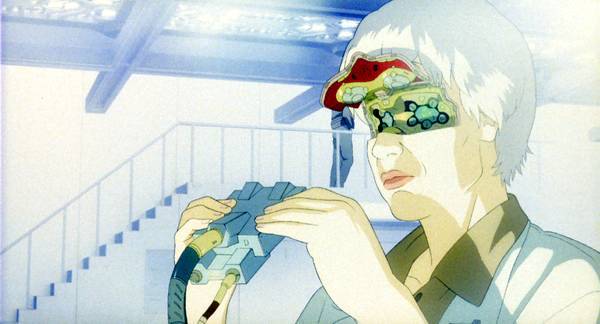Issue 4: Bodies and Borders
Persistence of Vision: A Cyborg Manifesto

A Cyborg Manifesto threw away the old modernist dichotomies to make space for the technological within feminism. What has been done with that space and what can we do with it now?
“I don’t think there’s ever been a phenomenon like ‘The Cyborg Manifesto’.” – Cary Wolfe
“I would rather be a cyborg than a goddess” – Donna Haraway

“Dr Haraway” in Ghost In The Shell 2: Innocence (2004).
Donna Haraway first published A Cyborg Manifesto in the Socialist Review of October 1985, immediately “thrilling cultural studies bods, new agers, feminists, and cyberpunks alike”1 and creating an intellectual and political splash the waves of which, thirty years on, still come crashing on the shores of academic departments across the world. Cyborg’s ideas paved the way for the research areas of cyborg anthropology, feminist technoscience, and cyberfeminism, to name a few, and it remains required reading in undergraduate seminars in anthropology, sociology, gender studies, queer theory, and history of science, and more. Matthew Gandy wrote in 2010 that “[Cyborg] is one of those rare instances where a piece of writing both reflects and ultimately shapes the momentum of a critical area of thought”2, but it wasn’t just the thinking in the academy that was impacted. Some of the ideas within Cyborg have become widely disseminated within broader culture, and the piece propelled Haraway herself into becoming, rarest of the rare, a public intellectual with a cult following in popular culture, even homaged in 2004 feature film Ghost In The Shell 2: Innocence (however it is not entirely true that “cyber” wouldn’t have been cool without Cyborg – Norbert Weiner’s cybernetics and Williams Gibson’s cyberpunk already gave the prefix intellectual fashionableness and aesthetic clout respectively). This is all to say, it is an important work. But, reader, you would be forgiven for never having read it, or having given it a go, quickly given up. Ironic in tone, grand in scope, and deeply embedded in the discourses of its time – “a heavily poetic and almost dream-state piece”3 – it is difficult to casually navigate. And, more to the point, difficult to immediately see what can we, as political actors, technologists, artists outside of traditional academic structures and discourses, gain from this text and its legacy.
What Cyborg accomplishes for its readers is a dissolving of borders, of borders between the organic and machinic, of nature and technology, of born and built, of human and tool; a dissolving of borders between political identities and ideologies. Haraway argues that American feminists (and socialists) of the time had integrated the modernist dualisms, which separated the sides of these borders into their political ideologies, in order to create a political project, the goals of which were to reclaim an imagined organic wholeness and essential unity, a “garden of Eden”, a place of innocence and unalienated labor, which she argues has never existed. The thinking of the second wave feminist movement, Haraway argues, equated the category of “woman” with nature, innocence, and victimhood in search of creating that essential unity, which is a myth that in her view prevented women from fully engaging with the world politically and paved over essential divisions in the category of “woman” along lines of race, class, and sexuality. Writing during the fragmentation of second wave feminism along just those lines, Haraway argued against what we today might call “white feminism” and its need for an essential category of “women” and instead took the view that postmodern affinity groupings, such as “women of color”, which centered the political place of the affinity group within greater structures of society and societal oppression. Thus even the boundaries around the woman identity needed to melted and recast without any notion of essentialism or purity.
Central to Cyborg’s borders-undoing power is Haraway’s mythos of the cyborg, a detourned vision of the cybernetic organism of science fiction and 1960s military literature. Haraway’s “hybrid of machine and organism” is a creature of “fiction and lived experience”, a fully alienated being “resolutely committed to partiality, irony, intimacy and perversity”, the “illegitimate offspring of militarism and patriarchal capitalism” . This cyborg is a new mythology to replace the innocent goddess myth, a being completely without natural wholeness, capable of either enforcing the reigning patriarchal order or undoing it completely. Inherent in this new mythology is the argument that “feminists definitely could and should use the master’s tools to destroy (or at least disrupt) the master’s house”4 –make use of technology as part of their political practice.
After electrifying academia’s halls for a few years, the ideas within Cyborg began to seriously spread at about the same time as the Internet’s popular adoption. In 1991 Australian art collective VNS Matrix created A Cyber Feminist Manifesto For The 21st Century5, an homage to and distillation of Cyborg, which gave these ideas a label: cyber feminism. This became one word, cyberfeminism, by 1994, when cultural theorist Sadie Plant used it to describe her own work and the growing area of feminist research on technology and the Internet. By the time the cyberfeminist collective the Old Boys Network (OBN) organized the First Cyberfeminist International6 at Documenta X in 1997, cyberfeminism had become a global art and political movement.
(Above) VNS Matrix Website, circa 1997. (Below) A billboard from VNS Matrix’s A Cyber Feminist Manifesto For The 21st Century.
Cyberfeminism is Cyborg’s most visible political legacy, fully embracing the manifesto’s postmodernity and eschewing any identification or structure. At the First Cyberfeminist International OBN created 100 anti-theses as a means to define cyberfeminism only by defining the things which cyberfeminism is not. But this lack of defnition left it politically unactionable and goalless, leading critics at the time to ask “where is the feminism in cyberfeminism?”7 Moreover the movement adopted a broad techno-utopianism, which had been lacking in Haraway’s more measured utopian vision, and created a sense of affinity based on career8 and not political goals, and, like the second wave feminism that Haraway was criticizing, had no place within its movement for race and no answer to racism; issues that would lead to its fizzling out along with the dot-com bubble at the beginning of the 2000s.
It is easy in hindsight to see why cyberfeminism began to languish as a movement. Right at the end of cyberfeminism’s heyday in 2000, Plant would write that “cyberspace is out of man’s control: virtual reality destroys his identity, digitalization is mapping his soul and, at the peak of his triumph, the culmination of his machinic erections, man confronts the system he built for his own protection and finds it is female and dangerous”9. In our contemporary moment, in 2018, when everyone is online, when women are routinely harassed by men wielding bot armies, when the Internet feels more like a tool for reactionary right wing politics and conspiracy than liberation, a tool to be abused by state authorities for surveillance and masculinist control…at this moment Plant’s statement feels crushingly, dishearteningly, painfully optimistic. Writing in 2016 in response to Plant, culture critic Cecilia D’Anastasio better reflected contemporary reality, saying that “cyberspace is hostile to women: our identities inside it are fixed and formulated into the lowest-common-denominator feminine, a depth encircled by barbs of masculinity lest we escape”10.
100 Anti-Theses from OBN.
How then can a feminism of technoscience address the current moment? In the past few years a new political movement, xenofeminism, has directly connected itself to the legacy of Cyborg and cyberfeminism in order to answer precisely that question. Begun in 2014 with the Xenofeminist Manifesto11 by collective Laboria Cuboniks, xenofeminism seeks to address the failings of cyberfeminism and create an intersectional political agenda for feminism in the face of the current state of monstrous global complexity, one that embraces the hard political work and long timeframe needed to achieve feminist goals. It’s a thrilling project, but one still in its early stages. Less than a year ago in November 2017, on the 20th anniversary of the First Cyberfeminist International, xenofeminist Helen Hester organized the Post-Cyber Feminist International at ICA, London12 as an event for xenofeminism agenda-setting and platform building, and it’s only been since this event that xenofeminism has begun to generate a foothold in popular awareness outside of art and academic circles.
Laboria Cuboniks’s website featuring The Xenofeminist Manifesto.
Two art and politics movements each with an additional manifesto: an enduring mythology of the highly capable feminist cyborg, and the undoing of pervasive myths of natural essentialism. Clearly A Cyborg Manifesto’s ideological lineage continues to provide sites for political and artistic engagement. And that makes sense; reading Cyborg today feels amazingly refreshing and relevant given that it is a dense work of a thirty four year old theory. A new edition just came out a little bit ago, from University of Minnesota Press, I encourage you to give it a go.
